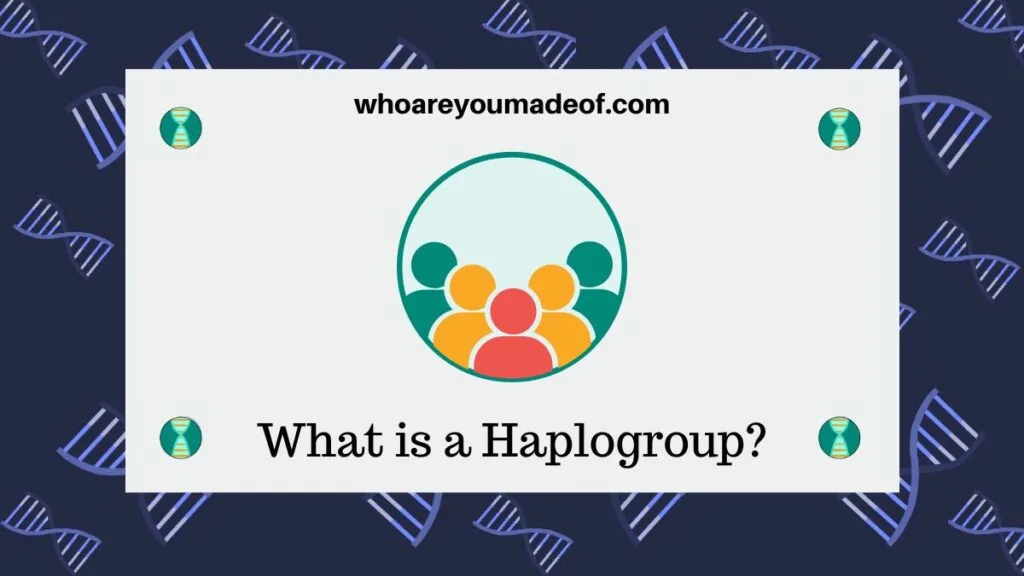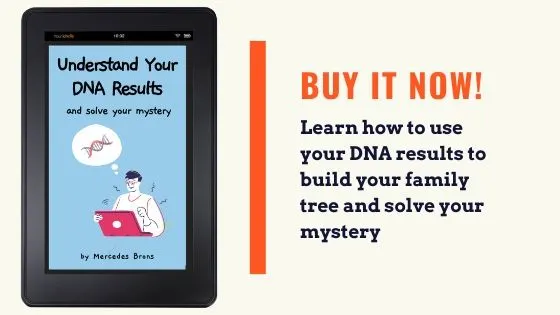Do you want to know what a haplogroup is? Are you wondering why a haplogroup is important, and how knowing your haplogroups can help you learn about your family's ancestry? You've come to the right place!
Haplogroups provide you a window into your family's ancient origins, but can also provide some information that is useful for more recent genealogy. They are surrounded with intrigue and mystery, and I'm glad you are interested in learning about them.

In this post, we'll discuss:
- The definition of a haplogroup
- The difference between maternal and paternal haplogroups
- Why people who are related have different haplogroups
- How haplogroups can help you with genealogy
- How to find out your haplogroups
I decided to write this article because I received a few questions about one of my most recent articles. Within the post, I mentioned haplogroups but provided no definition.
Upon further thought, I realized that there is a lot that can be said about haplogroups and that they deserve their own article on this site.
Haplogroups are important and extremely interesting!
What is a haplogroup?
A haplogroup is a group of people who share a common paternal or maternal ancestor. Your haplogroup is determined by your haplotype, which is a group of alleles inherited in a direct maternal or paternal line.
How do haplogroups get their names?
You might have noticed that haplogroups have a name that starts with a capital letter. I don't know why this was the chosen way to organize haplogroups, but I do know that haplogroups are assigned the first letter in the order of discovery.
This means that a haplogroup that starts with an "A" was the first haplogroup to be discovered.
Depending on the sensitivity of the DNA test that we take to test our maternal and paternal haplogroups, we might notice that our haplogroup has a capital letter with some other letters and numbers after it.
The letters and numbers stand for sub-groups, also called subclades, or our haplogroup. These groups can be assigned due to discovered mutations in the haplogroup that make it vary slightly from the parent group and "branch off" into its own subclade of the haplogroup.
The more detailed the haplogroup and subclade information, the more you can determine about your ancestry.
If you share a haplogroup are you related?
Yes, generally speaking, we are related to everyone who shares a haplogroup with us. A great example of this is the theory of Mitochondrial Eve, humankind's most recent common direct-line maternal ancestor.
Haplogroups are really quite amazing.
The exact genealogical relationship is usually difficult, or even impossible, to determine using only the haplogroup. Sharing a common maternal or paternal ancestor sometime in the past 5,000 years could mean that you could be 250th cousins, or siblings, or anywhere in between.
Also important to note is that the DNA that determines our maternal or paternal haplogroups accounts for a very small percentage of our total genome.
This means that if the only DNA that we have in common with someone is the small group of alleles that tell us the maternal or paternal haplogroup, we are not very closely related and could be VERY distantly related.
What is the difference between a maternal and paternal haplogroup
A maternal haplogroup is determined from mitochondrial DNA information passed down from females to all of her offspring. Paternal haplogroups, however, are determined from Y-DNA passed down only from fathers to sons.
Did you notice that females pass their maternal haplogroup information down to all of their children, but males pass their paternal haplogroup information down to only their male offspring?
Keep reading to find out why.
Do both males and females have haplogroups?
Every single human being belongs to a haplogroup. However, males have two haplogroups and females only have one. Sorry, ladies!
This is because males inherit a maternal haplogroup from their mother and a paternal haplogroup from their father. Females inherit only a maternal haplogroup.
How paternal haplogroups are inherited
Many of you might recall the XX and XY from your high school biology classes. The X and Y combination (or lack thereof) is what makes us male or female.
There are only two possible combinations of X and Y chromosomes. XX, and XY.
- Females inherit an X chromosome from both their mother and father and end up with two X chromosomes. Therefore, females are XX.
- On the other hand, males inherit one X chromosome (from their mothers) and a Y chromosome from their fathers. Therefore, males are XY.
Y-DNA is how paternal haplotypes are inherited and haplogroups assigned. The group of Y-DNA alleles that has been inherited through a direct male line for generations is contained within the Y chromosome.
Since females don't inherit Y-DNA, we don't have a paternal haplogroup.
How maternal haplogroups are inherited
Our maternal haplogroup information, even if we are male, is found within the mitochondria of our cells. That's why it is called mitochondrial DNA.
For short, we call mitochondrial DNA "mtDNA".
Scientists are not sure exactly why mitochondrial DNA is not passed down from fathers.
Since every human inherits mitochondrial DNA from their mother, every human, whether male or female, has mitochondrial DNA. This means that every human has a maternal, or mtDNA haplogroup.
Why people who are related to each other have different haplogroups
As you now know, males inherit their paternal haplogroup from their fathers and both males and females inherit their maternal haplogroup from their mothers.
The result of this is that close relatives can have different maternal and paternal haplogroups.
Male first cousins with different paternal haplogroups
For example, let's compare two male first cousins whose parents are sisters. Since each of the male cousins inherited Y-DNA from their unrelated fathers, they will likely have different paternal (Y-DNA) haplogroups.
If they did belong to the same paternal haplogroup, we could conclude that they had a common paternal ancestor somewhere further back in their direct paternal line. In other words, their unrelated fathers are actually related, perhaps very distantly, through both of their direct-line paternal ancestors.
Female first cousins with the same maternal haplogroup
What if those cousins above were female, descended from two sisters? Assuming those two sisters were full siblings with the same mother, the two first cousins would share the same maternal haplogroup.
This is because they are both descended in a direct female line from the same grandmother.
How you can use haplogroups for genealogy
If you share a haplogroup with someone, it is impossible to know (unless you have outside information) exactly how you are related to someone. The only thing you can be sure of is that you have a direct paternal (if you are male) or maternal ancestor in common.
Knowing this, how can we use haplogroups for genealogy?
There are many applications for haplogroups in genealogy, but I'll just show one here as an example.
Let's say that I am working on family tree and have met someone who believes that he is descended from my dad's great-great-great-great grandfather on his direct paternal line.
Perhaps there is doubt about whether our assumed cousin is really descended from this 4th great-grandfather. Maybe I have identified an alternative parent to his 3rd great-grandfather, meaning that we are possibly not related.
If he has Y-DNA results (a paternal haplogroup), he and my father should belong to the same one. If his paternal haplogroup doesn't match my father's (R-L2), then we can conclude that they are not descended from a common direct-line paternal ancestor.
In this case, we used Y-DNA paternal haplogroup information to disprove a genealogical theory.
If their haplogroups match, we still can't be sure that they do share the 4th great-grandfather. This is because they still might share a common direct paternal ancestor much further back than the 4th great-grandfather.
How to find your haplogroups
I have two recommendations for finding your maternal and paternal haplogroups. It is important to remember that females only have a mtDNA haplogroup, but they can ask their male relatives (i.e. brother, father, uncle, grandfather) to take a test to learn about their direct-line paternal ancestry.
If you are interested in knowing your basic haplogroups, as well as other DNA information, I recommend 23andMe as a reasonably priced option. You will learn your maternal haplogroup information (and paternal, if you are male), and you'll get everything else that comes along with 23andMe results.
You can get your DNA test from 23andMe using the following link. The basic "Ancestry Service" test will provide DNA matches, a ethnicity/ancestry estimate, and haplogroup(s):
For those who want very detailed haplogroup information, including subclades, I recommend Family Tree DNA.
Conclusion
I hope that this post has helped you understand more about haplogroups, how they can be useful to genealogy research, and which DNA test can help you learn your own haplogroups.
If you have a question or comment about something that you read in this post, or if you would like to share your haplogroup story with other readers, I would love to hear from you in the discussion below
Thanks for stopping by today!


Rick
Sunday 7th of May 2023
What if I share both male and female haplogroups with another person?
Erica Weinstein
Sunday 30th of January 2022
Question: Is it possible for a paternal 1st cousin & a paternal 1st cousin once removed to have different haplogroups?
Mercedes
Sunday 30th of January 2022
Hi Erica, That's a great question. Yes, it is possible for first cousins and first-cousins once-removed to have different paternal or maternal haplogroups. This is because males and females will inherit their maternal haplogroup from their mother and males will inherit their paternal haplogroup from their father. For example, if both the first cousin and the first cousin once-removed are male and descended from the same grandfather (through different male children of that grandfather, for example), then they should share a Y-DNA haplogroup. However, if one first cousin is a child of a female sibling of the male first cousin, they will have their father's Y-DNA haplogroup. An additional item of note is that as research continues on haplogroups, sometimes they are renamed, so if you think that two people should share the same haplogroup and they don't, double-check to see if there has been a redefining of the haplogroup in question. I hope that this helps you out, and good luck to you! Sincerely, Mercedes
Brandy
Thursday 28th of October 2021
What if a daughter shares her maternal and paternal haplogroup with her father?